Amaryllis plants are renowned for their striking, trumpet-shaped flowers and ease of growth, making them a favorite among both indoor and garden plant enthusiasts. These vibrant blooms add a splash of color to any space and are particularly popular during the holiday season. This complete guide will cover everything you need to know about Amaryllis: from planting and care to ensuring your plants bloom beautifully.
Understanding Amaryllis
Amaryllis plants are native to South America and belong to the Amaryllidaceae family. They are cherished for their large, showy flowers that come in a variety of colors, including red, pink, white, and bi-colored. These bulbs are easy to grow indoors and can also thrive outdoors in warmer climates.
What is Amaryllis?
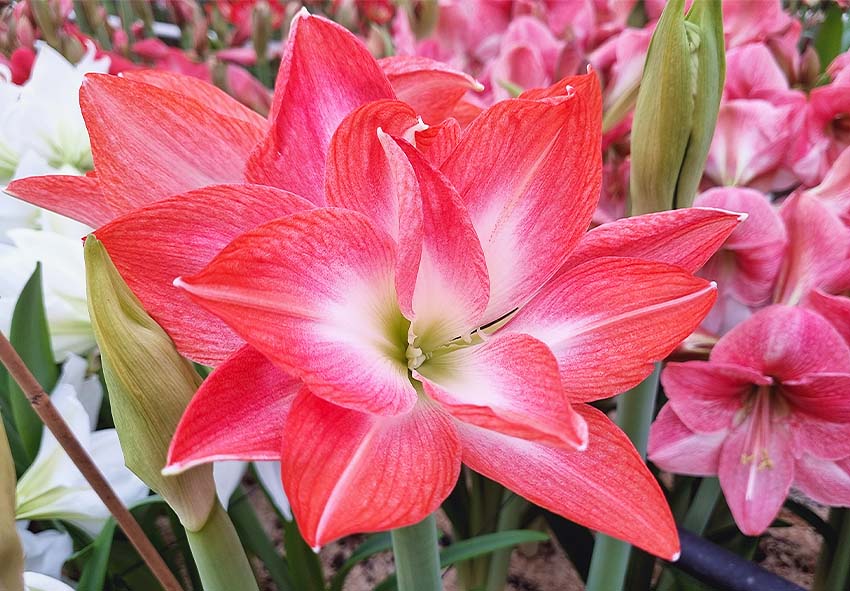
Amaryllis (Hippeastrum) is a bulbous plant that produces tall, sturdy stems topped with multiple large, trumpet-shaped flowers. Each bulb typically yields one or two flower stalks, each bearing two to five blooms. The plant’s strap-like leaves emerge either simultaneously with or after the flowering period. Amaryllis is often grown indoors during the winter months to provide a bright and festive display.
Popular Varieties of Amaryllis
There are many varieties of Amaryllis, each offering unique colors and patterns. Some popular choices include:
- ‘Red Lion’: Known for its deep red flowers and strong stems.
- ‘Apple Blossom’: Features delicate white petals with pink accents, creating a soft, romantic look.
- ‘Minerva’: Displays striking red petals with a white starburst pattern in the center.
- ‘Christmas Gift’: A favorite for holiday decorations, this variety has pure white flowers that symbolize purity and peace.
One of the most unique and captivating Amaryllis varieties is the Amaryllis in wax, which features a bulb encased in decorative wax that can bloom without soil or water, adding a touch of elegance and intrigue to any indoor space.
Choosing the Right Amaryllis for Your Garden
Selecting the perfect Amaryllis for your garden involves considering various factors such as climate, color preference, and bloom size. With numerous varieties available, each offering unique characteristics and beauty, making an informed choice can enhance the visual appeal and success of your garden:
| Botanical Name | Color | Flowering Period | Height | Fragrance | Climate |
| Hippeastrum ‘Apple Blossom’ | White with pink accents | Late winter to early spring | 18-24 inches | Light fragrance | Zones 8-10 (mild winters) |
| Hippeastrum ‘Red Lion’ | Bright red | Winter | 20-24 inches | None | Zones 8-10 (mild winters) |
| Hippeastrum ‘Minerva’ | Red with white stripes | Winter | 18-24 inches | None | Zones 8-10 (mild winters) |
| Hippeastrum ‘Papilio’ | Green with red veining | Spring | 24-30 inches | Light fragrance | Zones 8-10 (mild winters) |
Planting Amaryllis
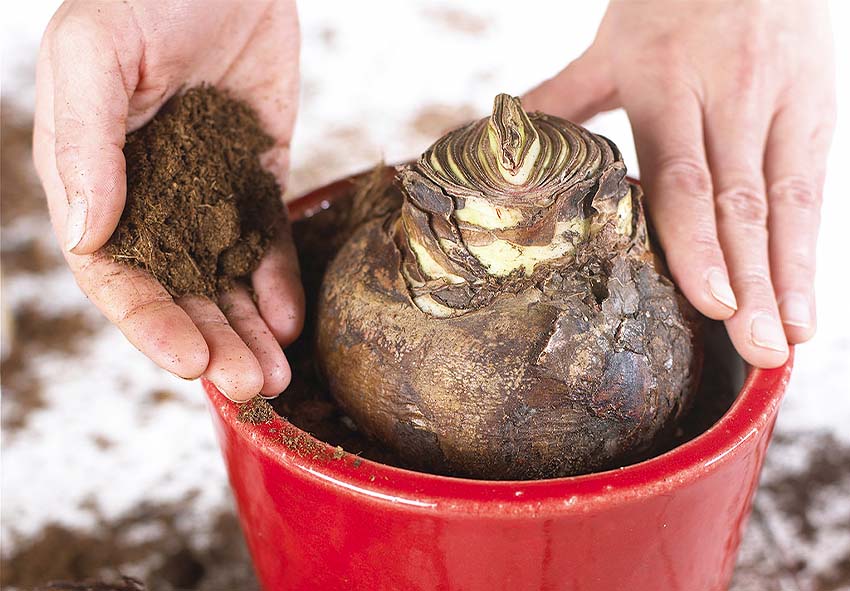
Planting Amaryllis bulbs is a straightforward process that rewards gardeners with spectacular blooms. Whether you’re growing them indoors to brighten up your home or outdoors in your garden, following the right planting techniques is essential for healthy growth and vibrant flowers. This section will guide you through selecting the best bulbs, understanding the ideal planting times and locations, choosing the right soil, and providing step-by-step planting amaryllis instructions.
Choosing the Right Bulbs
When selecting Amaryllis bulbs, it’s crucial to choose healthy, high-quality bulbs to ensure robust growth and vibrant blooms. Look for bulbs that are firm to the touch, free from cuts, soft spots, or signs of mold. Larger bulbs typically produce more flowers, so opt for the biggest bulbs you can find. Purchasing from reputable nurseries or online stores guarantees a better chance of receiving disease-free bulbs that will thrive in your garden or home.
When and Where to Plant
Amaryllis bulbs can be planted indoors at any time of the year, but they are most commonly planted in late fall to bloom during the winter months. For outdoor planting, the best time is after the last frost in spring when the soil has warmed up.
- Indoors
Planting indoors allows you to enjoy Amaryllis blooms year-round. Place them in a sunny spot, such as a south-facing window, where they can receive plenty of indirect sunlight.
- Outdoors
In regions with mild winters (zones 8-11), Amaryllis can be planted directly in the garden. Choose a location that receives morning sun and afternoon shade to protect the plants from intense heat.
Soil and Potting Requirements
Amaryllis thrives in well-draining soil. Use a high-quality potting mix designed for bulbs or create your own mix by combining equal parts potting soil, peat moss, and perlite or sand. This ensures good drainage and prevents waterlogged conditions that can cause bulb rot.
A well-draining potting mix is essential. Avoid using heavy garden soil, which can retain too much moisture. Choose pots that are 1-2 inches wider than the bulb, with drainage holes at the bottom. Amaryllis bulbs prefer to be slightly pot-bound, so there’s no need for overly large containers.
Step-by-Step Planting Instructions
Planting Amaryllis bulbs correctly sets the stage for healthy growth and beautiful blooms. Follow these steps for successful planting:
- Prepare the Pot: Select a pot with drainage holes and fill it with the potting mix, leaving about 1/3 of the bulb exposed above the soil surface.
- Position the Bulb: Place the bulb in the center of the pot, roots facing down. Press the bulb gently into the soil to secure it in place.
- Add Soil: Fill around the bulb with more potting mix, leaving the top third of the bulb exposed. Firm the soil gently around the bulb to eliminate air pockets.
- Watering: Water the bulb thoroughly after planting, ensuring the soil is evenly moist but not waterlogged. Allow the top inch of soil to dry out between waterings.
- Placement: Place the pot in a bright location with indirect sunlight. Ideal temperatures for growth range from 60-75°F (15-24°C).
By following these planting guidelines, your Amaryllis bulbs will be well on their way to producing stunning flowers that can brighten any indoor or outdoor space.
Caring for Amaryllis
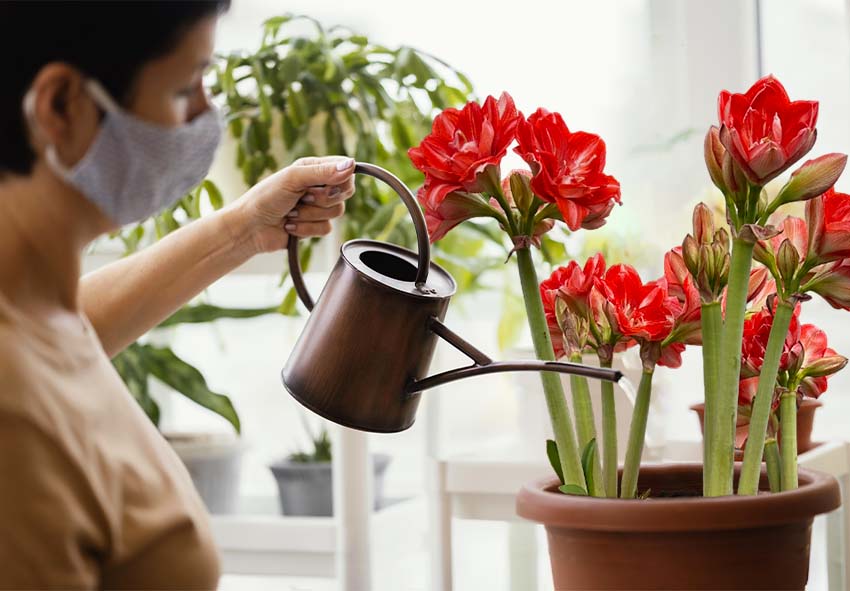
Caring for Amaryllis plants properly ensures they remain healthy and produce their stunning blooms year after year. Understanding the specific needs of Amaryllis, from watering and light requirements to fertilizing and pruning, is essential for their successful growth. This section will provide detailed guidelines on how to care for your Amaryllis plants during different stages of their life cycle, helping you maintain their beauty and vitality.
Watering Needs
Proper watering is crucial for the healthy growth of Amaryllis plants. During the initial growth stage, water the bulbs sparingly until new shoots appear. Once the plant starts to grow, increase the watering frequency to keep the soil consistently moist but not waterlogged. During the blooming period, continue regular watering to support the flowers. After the flowers fade and the plant enters its dormant phase, reduce watering significantly and allow the soil to dry out between waterings to prevent bulb rot.
Light and Temperature Requirements
Amaryllis thrives in bright, indirect light. For indoor plants, place them near a south or west-facing window where they can receive plenty of sunlight but be protected from direct, harsh rays. Outdoor Amaryllis should be planted in a location that receives morning sun and afternoon shade to avoid overheating. Ideal indoor temperatures range from 60-75°F (15-24°C) during the growing season. Outdoor plants should be protected from frost and extreme cold.
Fertilizing Amaryllis
Fertilizing Amaryllis is essential to provide the nutrients they need for robust growth and vibrant blooms. Use a balanced, water-soluble fertilizer (such as 10-10-10) every two to four weeks during the active growing and blooming period. Start fertilizing when new growth appears and continue until the flowers have faded. Avoid fertilizing during the plant’s dormant phase, as this can cause stress and hinder future growth.
Pruning and Deadheading
Pruning and deadheading Amaryllis are important for maintaining plant health and encouraging new growth. After the flowers fade, cut the flower stalks back to the top of the bulb but leave the foliage intact. The leaves will continue to photosynthesize and store energy in the bulb for the next flowering cycle. Regularly remove any yellow or dead leaves to keep the plant tidy and free from disease. Deadheading spent blooms prevents the plant from wasting energy on seed production and encourages it to focus on bulb and leaf development.
Encouraging Blooming
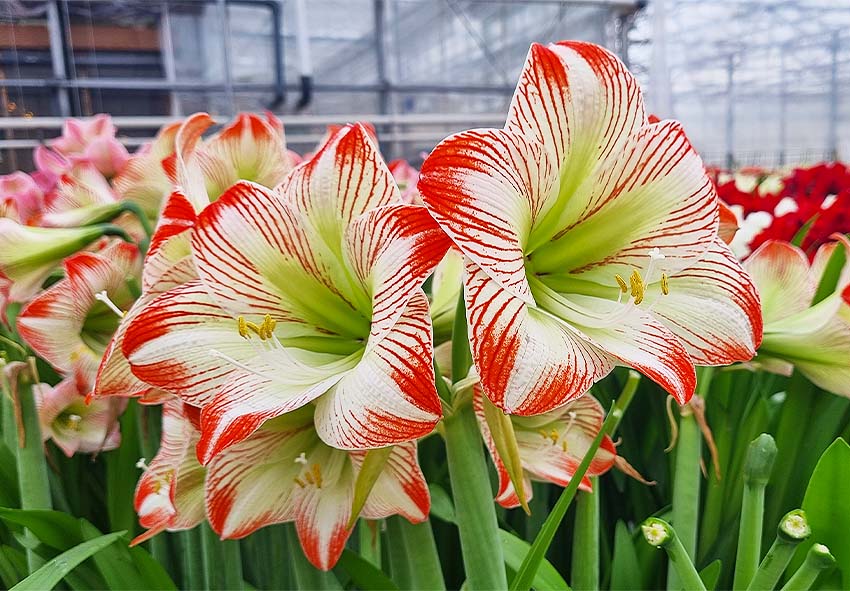
Encouraging your Amaryllis to bloom involves understanding its natural growth cycle and creating the right conditions for flowering. With proper care and attention, you can enjoy vibrant Amaryllis blooms year after year.
Dormancy Period
The dormancy period is crucial for the health and blooming of Amaryllis plants. After the flowering season, reduce watering and allow the leaves to yellow and die back naturally. This period, which typically lasts for 8-10 weeks, allows the bulb to rest and store energy for the next growth cycle. Keep the bulbs in a cool, dry place during dormancy, ideally at temperatures between 50-55°F (10-13°C). Managing this period correctly ensures robust blooms in the following season.
Forcing Blooms Indoors
Forcing Amaryllis bulbs to bloom indoors out of their natural season can provide beautiful flowers during the winter months. To do this, start by giving the bulbs a proper rest period. After dormancy, replant the bulbs in fresh potting mix and place them in a warm, sunny location. Water the bulbs thoroughly, and continue to water regularly as new growth appears. The warmth and light will stimulate the bulbs to break dormancy and initiate blooming, usually within 6-8 weeks.
Common Blooming Problems and Solutions
Several issues can prevent Amaryllis from blooming, but they can often be resolved with a few adjustments:
- Insufficient Light: Ensure the plant receives adequate sunlight. Indoors, place it near a bright window. Outdoors, select a spot with morning sun and afternoon shade.
- Improper Watering: Overwatering can lead to bulb rot, while underwatering can prevent blooming. Maintain consistent moisture without waterlogging the soil.
- Nutrient Deficiency: Regularly fertilize your Amaryllis during the growing season with a balanced fertilizer to provide essential nutrients.
- Lack of Dormancy: Skipping the dormancy period can hinder blooming. Ensure the bulbs receive a proper rest phase with reduced watering and cooler temperatures.
By addressing these common issues and providing the right care for Amaryllis after blooming, you can encourage your flowers to produce spectacular blooms, enhancing the beauty of your indoor or outdoor garden.
Amaryllis Aftercare
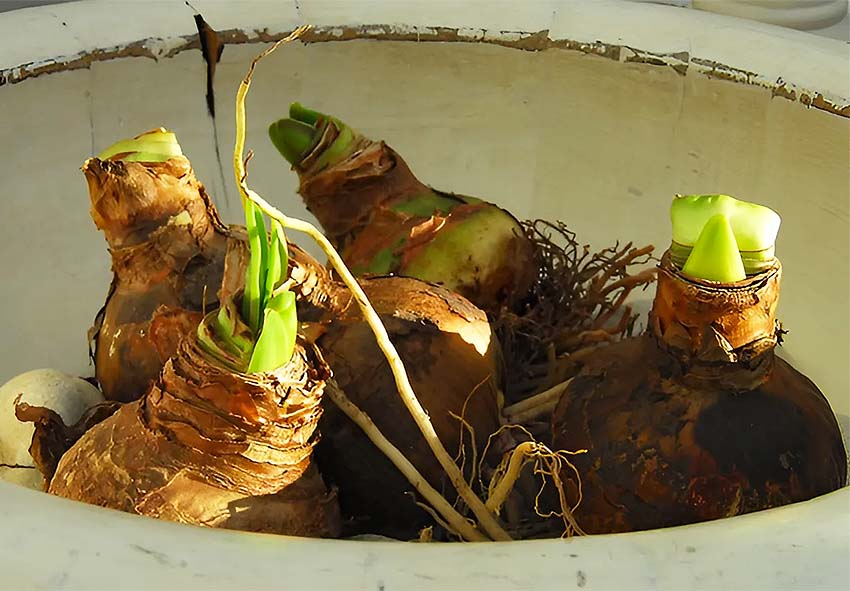
Proper aftercare of Amaryllis plants ensures they remain healthy and ready to bloom again in the next season. Following specific steps after the blooming period ends, through dormancy, and during repotting will help maintain the vitality of your Amaryllis bulbs.
Post-Bloom Care
After the Amaryllis flowers have faded, it’s important to cut back the flower stalks to about an inch above the bulb. This prevents the plant from wasting energy on seed production. However, leave the green foliage intact, as it continues to photosynthesize, providing energy that is stored in the bulb for next year’s growth. Continue to water the plant regularly and provide monthly feedings with a balanced fertilizer. Keep the plant in a sunny location to ensure it receives enough light for the leaves to thrive.
Storing Bulbs for Next Season
Once the leaves begin to yellow and die back, it’s time to prepare the bulbs for dormancy. Stop watering and feeding the plant, and allow the leaves to wither naturally. This process signals the plant to enter its rest phase. Remove the bulbs from the soil, clean off any remaining soil, and place them in a cool, dry place with good air circulation. Ideal storage temperatures range from 50-55°F (10-13°C). Keep the bulbs in a dark environment, such as a paper bag or a cardboard box, for 8-10 weeks before replanting.
Repotting Amaryllis
Repotting Amaryllis is best done every 2-3 years or when the bulb outgrows its pot. After the dormancy period, it’s the perfect time to repot the bulbs. Choose a pot that is about 1-2 inches larger in diameter than the bulb, ensuring it has proper drainage holes. Fill the pot with fresh, well-draining potting mix, and plant the bulb with the top third exposed above the soil surface. Water thoroughly after planting and place the pot in a sunny, warm location. Regularly monitor the plant for new growth and continue with a routine care schedule to encourage healthy development and blooming.
By following these aftercare steps, you can ensure your Amaryllis bulbs remain healthy and vigorous, ready to produce stunning flowers year after year. Proper post-bloom care, storage, and repotting are key to maintaining the long-term vitality of your Amaryllis plants.
Common Pests and Diseases
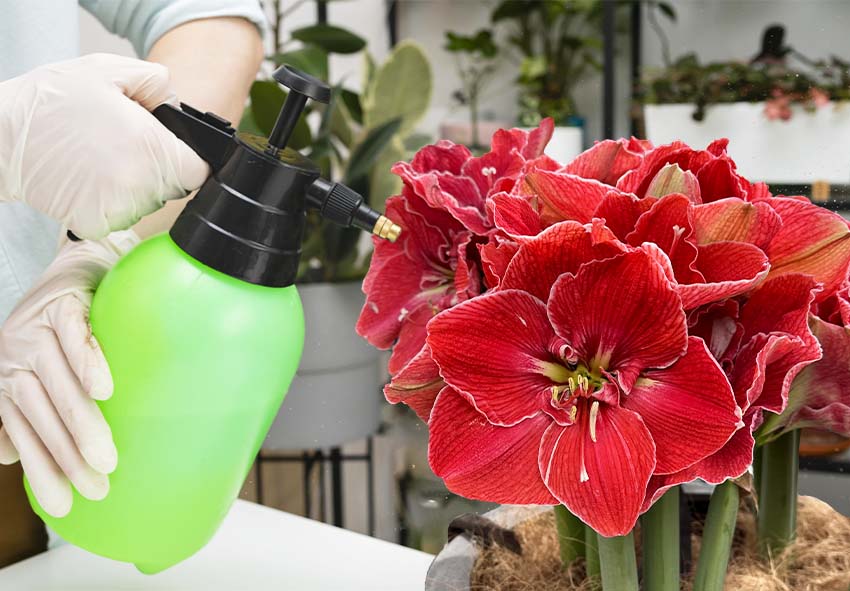
Amaryllis plants, like all plants, can be susceptible to pests and diseases. Identifying these issues early and knowing how to treat them is crucial for maintaining the health of your Amaryllis and ensuring it continues to bloom beautifully.
Identifying Common Pests
Several pests commonly affect Amaryllis plants. Recognizing these pests and their signs can help you take prompt action:
- Aphids: These small, green or black insects cluster on new growth and the undersides of leaves. They suck sap from the plant, causing leaves to curl and yellow. Look for sticky honeydew on the leaves and stems, which is a telltale sign of aphid infestation.
- Spider Mites: Tiny, red or brown mites that create fine webbing on the undersides of leaves. They cause stippling and a bronze discoloration on leaves. Severe infestations lead to leaf drop.
- Mealybugs: Small, white, cottony masses found on the leaves, stems, and roots. They weaken the plant by sucking sap, leading to stunted growth and yellowing leaves.
- Bulb Mites: These pests attack the bulbs, causing them to rot. Affected bulbs will have soft spots and may emit a foul odor.
Preventing and Treating Diseases
Proper care and maintenance are key to preventing diseases in Amaryllis plants. However, if diseases do occur, early treatment can save your plants:
- Red Blotch (Stagonospora curtisii): This fungal disease causes red spots and streaks on the leaves, stems, and bulbs. Prevent it by avoiding overhead watering and ensuring good air circulation. Treat infected plants with a fungicide, and remove any affected leaves to prevent the spread.
- Root Rot: Often caused by overwatering or poorly drained soil, root rot leads to soft, brown roots and yellowing leaves. Prevent it by using well-draining soil and pots with drainage holes. If rot occurs, remove the plant from the pot, trim away the affected roots, and replant in fresh soil.
- Fusarium Bulb Rot: This soil-borne fungus causes bulbs to rot from the inside out. Affected bulbs will be soft and may emit a foul smell. Prevent this by using sterile soil and pots, and avoid overwatering. Discard any infected bulbs to prevent the spread to healthy plants.
By regularly inspecting your Amaryllis for signs of pests and diseases and taking appropriate preventive measures, you can keep your plants healthy and vibrant. Quick identification and treatment of issues are essential to maintaining the beauty and longevity of your Amaryllis blooms.
Creative Uses for Amaryllis
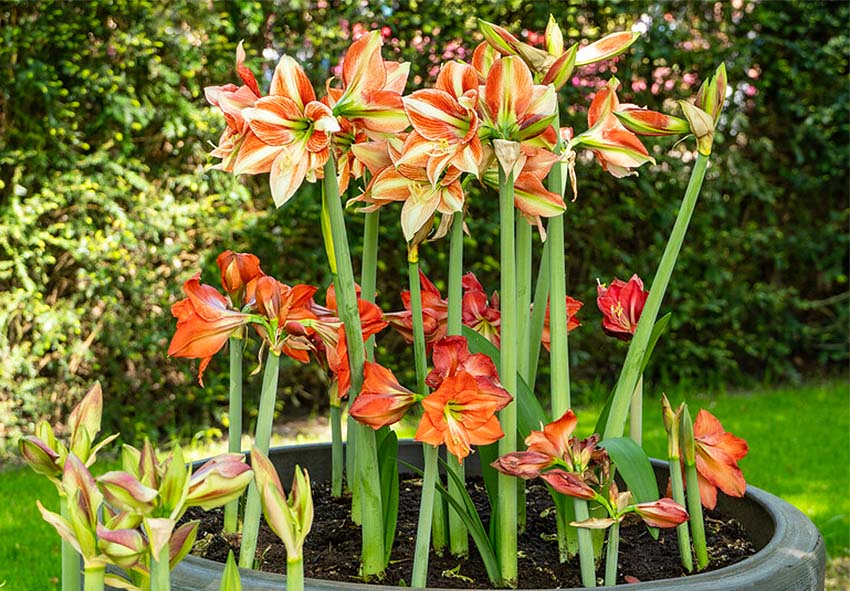
Amaryllis plants offer more than just beautiful blooms—they can also be used in creative ways to enhance your home decor and delight your loved ones. Explore these imaginative ideas for incorporating Amaryllis into your life.
Amaryllis in Floral Arrangements
Add a touch of elegance to your floral arrangements by including Amaryllis blooms. Their large, showy flowers make them a focal point in any bouquet or centerpiece. Pair them with complementary flowers like roses, tulips, and greenery for a stunning display. Amaryllis flowers also look striking on their own in a tall vase, showcasing their beauty and grace.
Amaryllis as Gift Plants
Give the gift of beauty and joy with Amaryllis bulbs or potted plants. Amaryllis bulbs make thoughtful gifts for gardeners of all skill levels, providing them with the opportunity to grow their own stunning blooms. Choose bulbs in festive colors like red and white for holiday gifts, or opt for unique varieties to suit the recipient’s taste. Potted Amaryllis plants are perfect for special occasions like birthdays, anniversaries, or housewarmings. Pair them with a decorative pot or basket for an extra-special touch.
Decorative Potting Ideas
Elevate the presentation of your Amaryllis plants with creative potting ideas. Choose pots or containers that complement the colors of the blooms and the decor of your home. Get creative with embellishments like bows or decorative stones to add a personal touch to your potted Amaryllis displays:
- Vintage Containers: Plant Amaryllis bulbs in vintage tin or ceramic containers for a rustic charm.
- Modern Pots: Showcase Amaryllis plants in stylish, modern pots for a contemporary aesthetic.
- Personalized Touch: Add embellishments like ribbons, bows, or decorative stones to customize your potted Amaryllis displays.
Whether you’re arranging flowers, giving gifts, or decorating your home, Amaryllis plants offer endless possibilities for creativity and beauty. Explore these imaginative uses for Amaryllis to bring joy and elegance into your life and the lives of those around you.
Conclusion
As you embark on your journey of growing and blooming Amaryllis plants, remember to apply the tips and techniques shared in this guide. Our blog is the best place to find any information you need. With proper care, attention, and creativity, you can cultivate vibrant blooms and enhance your home with the beauty of Amaryllis. Whether you’re a seasoned gardener or a beginner, the joy of seeing your Amaryllis bulbs transform into stunning flowers is unparalleled. Embrace the process, enjoy the journey, and may your Amaryllis blooms bring you endless happiness and delight.
Frequently Asked Questions (FAQs) about Amaryllis
1. What type of soil is best for planting Amaryllis bulbs?
Amaryllis bulbs thrive in well-draining soil. Use a high-quality potting mix designed for bulbs or create your own by mixing equal parts potting soil, peat moss, and perlite or sand to ensure good drainage.
2. Can I grow Amaryllis bulbs outdoors?
Yes, Amaryllis bulbs can be grown outdoors in regions with mild winters (zones 8-10). Plant them in a location that receives morning sun and afternoon shade after the last frost in spring. Indoors, they can be planted at any time of the year.
3. Can I purchase Dutch Amaryllis bulbs from your online store?
Yes, you can find a variety of Amaryllis bulbs available for purchase in our online store Dutch-bulbs.com. We offer a range of colors and varieties to suit your preferences. Our bulbs are carefully selected for quality, and we provide detailed planting and care instructions to help you successfully grow beautiful Amaryllis flowers in your own home.
4. How do I encourage my Amaryllis to bloom again next year?
After the flowers fade, cut back the flower stalks and continue to care for the foliage by providing adequate light and water. Feed the plant with a balanced fertilizer until the leaves die back naturally. Store the bulb in a cool, dry place during dormancy before replanting.
5. What should I do if my Amaryllis is not blooming?
Ensure your Amaryllis is receiving sufficient light, water, and nutrients. Check for pests and diseases, and make sure the bulb underwent a proper dormancy period. Adjust care practices accordingly, such as improving light exposure or soil drainage, to encourage blooming.
Published: 04.06.2024
